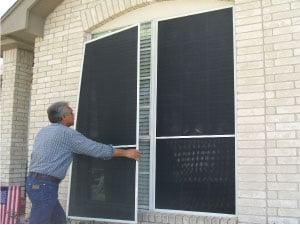Window Replacements | Window Treatments
A Review of Solar Screens: Pros and Cons You Should Consider
April 5th, 2013 | 2 min. read
By Jenica Lee
Get weekly updates with the most recent articles and videos from Southwest Exteriors.
Subscribe
San Antonio homeowners have tried various ways to keep the summer sun from blasting into their windows, overworking their air conditioning unit, and driving up their electricity bill. We’ll explore the options of solar screens, tinted window film, and Low-E glass for reducing heat transfer into your home through your windows, and we’ll look at the benefits and disadvantages of each. Today’s topic is solar screens.
How Do Solar Screens Work?
Solar screens are made of special window screen mesh, often a polyester weave and sometimes made with the added durability of PVC coating. They are typically installed on the outside of windows, essentially blacking them out. Although this is not the most efficient means of reducing heat transfer through the glass, solar screens do help with solar heat gain coefficients. The National Fenestration Rating Council is a third-party government entity that rates windows according to how well windows insulate, but unfortunately they do not have ratings on solar screens.Solar Screen Cons and Problems
From an aesthetics standpoint, these screens are very dark, so they tend to make the house to look like a large version of Elvis Presley wearing huge black 1970s sunglasses. The look does not enhance the overall beauty of a neighborhood. These screens also can darken the inside of your home, causing you to spend more money on lighting your home through electricity instead of sunlight. Reducing the natural light levels in your home has also been shown to have negative impacts on your health, such as reducing serotonin and endorphins, which can bring down a person’s overall mood.
There are other drawbacks to solar screens, as well, such as the possibility of them blowing away or being damaged in storms since they are an after-market addition to your windows and may not have the most secure fit. Depending on the weather trends of the area, some solar screen companies actually suggest installing them on the interior of your windows to protect them. The screens also are thick enough to inhibit some airflow if you like to open your windows for ventilation.
Solar Screen Pros, Benefits, and Cost Savings
The real advantage to solar screens is that they are one of the most inexpensive solutions available. If you do the measurements and installation yourself, they can cost less than $50 for an average 35 X 70 inch window. If you have a contractor install them professionally, you could spend around $7.50 a square foot. Compared to complete window replacement, this is definitely a cheaper option, particularly if you are just looking for a temporary solution. Solar screens can also provide some privacy for the interior of your home during the day; however, you should know that if you have lights on in the house at night, the screens will no longer block the view into the house from the outside.
In our next blog post, we’ll discuss the option of using tinted window film to reduce heat transfer through your windows and see how it compares to solar screens. If you have any further questions, please feel free to contact us directly.

